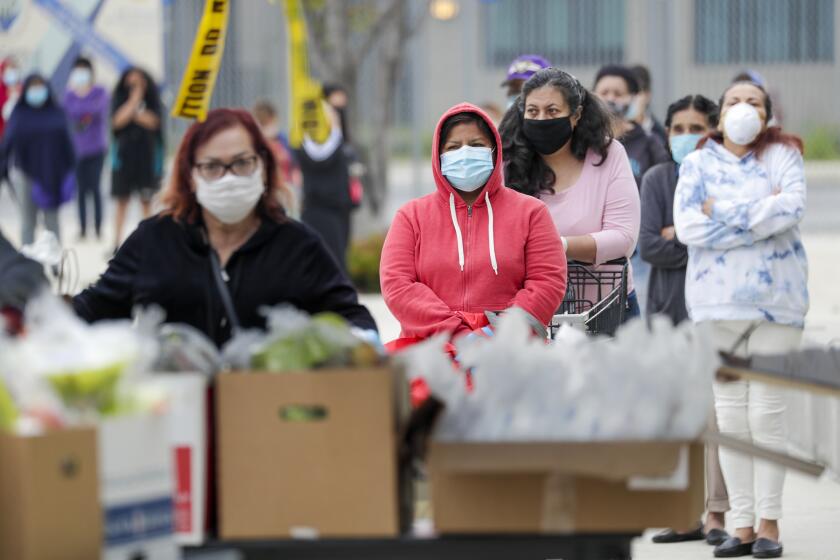In rural California, children face isolation, hunger amid coronavirus school closures
- Share via
With schools closed because of the coronavirus, educators in vast stretches of rural California are struggling not only to teach their students but to reach them.
From the mountain hamlets of Northern California to the farming communities of the Central Valley to the desert towns near the U.S.-Mexico border, small schools are grappling with how to serve far-flung, impoverished students with less access to at-home internet, spotty cellphone service and who rely on schools to feed them.
In Trinity County, some bus drivers are traveling up to 1.5 hours along winding mountain roads to deliver two meals per day to families who can’t afford to drive into town. In Siskiyou County, students are dropping off homework on teachers’ front porches. In Tulare County, one tiny district hurriedly installed internet antennae throughout town, including the roofs of some houses.
Coronavirus cases are slowly creeping into vast, rural Northern California. Only a handful of counties had no cases.
Students in one district are riding out the coronavirus outbreak with family in Mexico, where they can get better internet service.
“We don’t know where we’re going, how we’re going to get there or what it’s going to look like at the end,” Katie Squire, a second-grade teacher in the Kings County town of Avenal, said of teaching during the pandemic. “It’s like flying the plane and building it at the same time.”
The pandemic has widened the gulf between the digital haves and have-nots, said Niu Gao, a researcher for the Public Policy Institute of California. In rural California, some 41% of households with school-age children do not have broadband access at home, much higher than the statewide average of 27%, Gao said.
Broadband infrastructure can cost more to build in remote places with fewer customers, and families have fewer service providers and prices to choose from. In some areas, Wi-Fi hotspots do not work.
State officials, who last week convened a new task forced aimed at closing the digital divide, are far behind in a race to provide computers and internet connectivity that California students need to finish the school year remotely. Although 70,000 computers and 100,000 hotspots have been pledged to date, officials say it is not enough.
The state estimates that more than 400,000 more computers and hotspots are needed and that 200,000 additional households with students are without them. Other surveys put the need even higher.
“Rural California has been screaming from the top of our lungs about the digital divide for years,” said state Sen. Mike McGuire (D-Healdsburg), who represents seven counties stretching from Marin north to Del Norte.
“Once this pandemic is over, my hope is this: that the needs of rural California have been exposed and we open up a sustained effort to connect schools in rural communities with high-speed internet.”
Gary Mekeel is the superintendent of the Alpaugh Unified School District in Tulare County, which serves some 350 students, many from fieldworker families.
As coronavirus deaths jump in rural Tulare County, a push for residents to take outbreak seriously
After campuses closed, the district cut spending for other student programs and spent just over $50,000 to install about 40 internet antennae throughout the town of 1,000 people and to buy hotspots for more isolated families, Mekeel said.
“With COVID-19, we just decided to go into the reserves to get it done,” he said. “I’m not complaining, but that’s a huge expenditure for a little district.”
The antennae now stand on the school and atop the fire department and local library. Some sit on families’ homes.
“Every family that we asked — I’m not sure any of them own their homes, but they gave us permission,” Mekeel said. “At least for now, the town’s covered. That happened in two weeks.”
Rindy DeVoll, executive director of the nascent California Rural Ed Network, said that even before the COVID-19 pandemic, educators in rural schools with fewer resources were overwhelmed because they “wear so many hats” — like teaching several grade levels or having one special education teacher serve an entire district.
“The superintendent or principal may know every student in the district,” she said. “Sometimes we have that sort of isolated feel. ... There’s a real sense of independence. But if you need help? We’re right there for you. That bleeds over into the school systems. The schools really are our community centers.”
Rauna Fox, superintendent of the San Pasqual Valley Unified School District in Winterhaven, said it is “the epitome of a wraparound district,” providing services that go far beyond classroom teaching.
About half of the Imperial County district’s roughly 700 students are Native American and most of the others are Latino, Fox said. Virtually all of them qualify for free breakfast and lunch. Until the pandemic struck, the district offered dinner to all children in the community, whether they are enrolled or not.
Although Winterhaven is a few minutes from Yuma, Ariz., many families rely on Medi-Cal for healthcare, meaning that rather than cross the nearby state border for dentist or eye doctor appointments, they have to travel an hour west to El Centro.
Before the pandemic, school district employees often drove students whose families lacked transportation, along with a parent or guardian, to those appointments.
Fox said she’s not sure whether the district can offer that service once schools reopen given that the trips require people to sit close together at a time when social distancing is needed to slow the spread of the coronavirus.
The Los Angeles school district racks up $200 million in emergency coronavirus costs, from meal programs to computers, and the budget outlook is uncertain at best.
Fox said that no more than 40% of her students have reliable internet access at home. Before the coronavirus, students would come to campus before school or stay afterward and use the internet to complete assignments.
A private service provider was set to build a 180-foot tower in Winterhaven by the summer through the Imperial County BorderLink project to provide free online access to students. But in a cruel twist, the pandemic put construction on hold just as schools were switching to distance learning.
Some students, Fox said, are staying with family in Mexico — where they can find better internet service.
Squire, the second-grade teacher in Kings County, said she worries about her young students not having basic learning supplies during the pandemic. She teaches in the Reef-Sunset Unified School District in Avenal and said the closures happened so abruptly that students were unable to pick up items like paper and crayons.
“Maybe a family can go to the dollar store and get a package of paper, but is that going to be a priority?” she said. “It’s part of dealing with a community that has an extremely low income.”
In Siskiyou County, home to some 43,000 people in a place eight times larger than Orange County, there were only five confirmed cases of the coronavirus infection as of Tuesday. Marie Caldwell, superintendent of the Scott Valley Unified School District, said families “are getting antsy, asking why we are still closed.”
“We’re very isolated,” she said. “Families can’t just walk around the corner to the grocery store. Food insecurity was already a pretty big concern in our county.”
As the length of the pandemic stretches and more people lose their jobs, the number of families relying on school-provided meals is growing, she said.
The Scott Valley is surrounded by mountains. Cell service is bad. Wi-Fi hotspots don’t work. Many families use satellite for internet, but it is slow and buggy.
Regina Hanna, principal of Etna High School in the Scott Valley district, said some students are relying on printed homework packets and phone calls from their teachers. Some school vans that are delivering meals also pick up schoolwork from students. Hanna accepts homework in her home mailbox.
Her school has also worked with the Etna Police Department to do welfare checks on students. But some students, and their families, have fallen off the school’s radar.
In mountainous Trinity County, where there were no confirmed coronavirus cases as of Tuesday, the pandemic has added to an already devastating year for students in Weaverville.
School bus drivers are continuing their regular routes to deliver meals. During spring break, the district provided 3,500 meals for local children, whether they are enrolled or not.
“Thirty-five hundred meals tells you how much COVID-19 has hit this proud town,” said Trinity Alps Unified School District Supt. Jaime Green. “They can’t afford to go to the market because they’re not working. These are little babies. We have to feed them.”
Last summer, the county shut down the campuses of Weaverville Elementary and Trinity High School after the discovery of toxic black mold in the walls, the ceilings and the carpeting.
The district had to rent about 30 portable buildings for classrooms and offices while also trying to rebuild the two gutted campuses. The district “almost went bankrupt,” Green said. It cut supplies, depleted its reserves, laid off staff and decided not to replace some staffers who resigned or retired. But he thought they had turned a corner.
“We were finally at a point where we were going to be OK. We had to let staff go, had to downsize, and it was like, ‘OK, we’re going to be all right,’ ” Green said. But the coronavirus outbreak, he said, is going to crush the district’s already stripped-down budget.
“When you get this low,” Green said, “it is really hard to keep functioning.”
More to Read
Sign up for Essential California
The most important California stories and recommendations in your inbox every morning.
You may occasionally receive promotional content from the Los Angeles Times.














